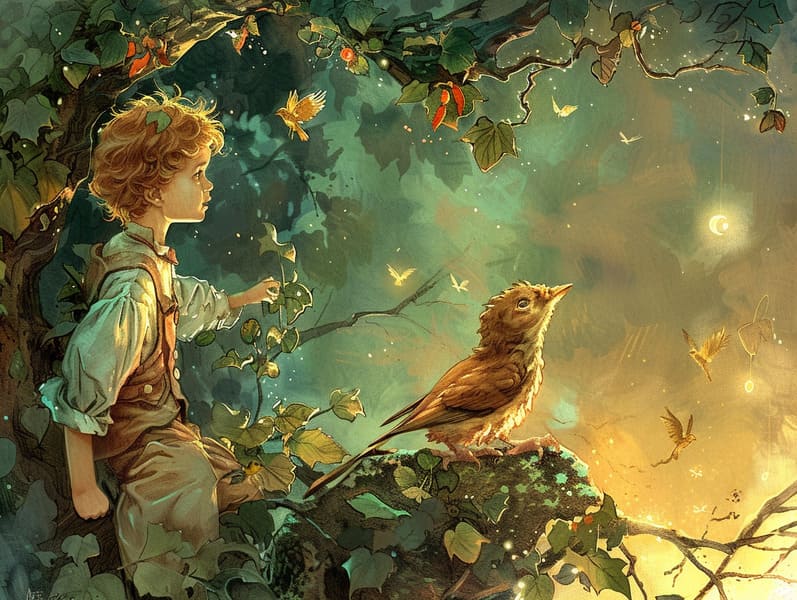
Traditional fairy tales have enduring presence. These stories have been narrated from one generation to the next long before they were ever put on paper. They developed from a variety of civilizations, including European traditions. They were initially disseminated among older generations, often carrying themes and messages aligned with the societal norms and beliefs of the time.
The famous Grimm duo, Jacob and Wilhelm, were among the first to compile and release many of these beloved stories. Their published works, "Grimm's Children's Stories," included tales like "The True Bride," "Little Brother and Little Sister," and "Little Snow White," which have since become classics in the world of timeless fairy tales. Similarly, the Danish author's fantastical narratives, such as "The Sea Maid," and "The Story of the Ugly Duckling," have touched hearts worldwide, securing their place in the pantheon of iconic fairy tales.
Even though they are old, traditional fairy tales remain as relevant as ever, especially as bedtime stories for kids. These charming stories are now available in numerous formats, including richly illustrated books, whimsical animations, and internet fairy tales.
Their continued relevance can be attributed to several delightful features:
Valuable Lessons: Traditional fairy tales often illustrate important moral lessons. Fairy tales like "The Tale of the Boy Who Cried Wolf" teach the virtue of being truthful, while "The Race of the Tortoise and the Hare" emphasize the qualities of steadfastness and unpretentiousness. These stories offer young ones clear distinctions between right and wrong, shaping their moral compass in a mild yet profound way.
Empathy and Awareness: Fairy tales frequently illustrate personalities facing problems and hurdles, fostering young listeners to relate with their struggles and rally behind their triumphs. For instance, "The Tale of Beauty and the Beast" shows us the virtue of looking beyond appearances to see the inner self of a soul, strengthening compassion and recognition.
Cultural Knowledge: Many timeless fairy tales are steeped in the cultural contexts from which they blossomed. Delving into these fairy tales can provide intriguing perspectives into different heritages, cultivating a sense of international awareness and discernment.
Creativity and Fantasy: The fanciful elements in classic fairy tales—enchanted objects—generate children’s creative minds. These fairy tales bring readers to otherworldly realms, firing up creative ideas and a sense of delight that stays a lifetime.
Old fairy tales are not only entrancing but also educational. They act as bewitching tools in fostering various mind and heart abilities in little ones. When classic fairy tales are voiced, they cultivate language skills by offering new language and detailed sentence structures. This practice also fosters listening skills and mindfulness, as the young remain attentive, anticipating to see what happens next.
Furthermore, discussing the themes and characters of ancient fairy tales can nurture thought processes and critical thinking. The young are shown to notice patterns, make predictions, and realize cause and effect. These discussions also ease young readers speak out their thoughts and feelings, advancing their emotional intelligence.
In today’s high-tech era, the accessibility of digital fairy tales has made these stories more attainable than ever. Web platforms and apps give extensive collections of old fairy tales that can be enjoyed or listened to anytime, anywhere. Fairy tales voiced are particularly popular, providing an charming way for young ones to delight in these fascinating tales. Spoken stories and spoken videos take characters and settings to life, often joined by spellbinding soundtracks and harmonies that raise the storytelling journey.
The timeless appeal of old fairy tales these guys lies in their ability to transform to today's world while keeping hold of their central messages. Contemporary modernizations of these narratives often show more representative figures and modern settings, making them relatable to today’s audience. However, the main ideas of fearlessness, compassion, and justice remain unchanged, continuing to strike a chord with young listeners of all ages.
Timeless fairy tales also offer a sense of comfort and recognition. They introduce a structured narrative with a obvious beginning, middle, and end, often ending with the solving of conflicts and the triumph of righteousness over wickedness. This constancy can be placating for young readers, making known a sense of reliability in an ever-changing world.
Ancient fairy tales continue to captivate and coach new generations, maintaining their grace and applicability in modern society. As kids' bedtime tales, they offer a perfect blend of magic and knowledge, aiding moral values, empathy, and creativity. The prevalence of internet fairy tales and the well-liked nature of fairy tales read out loud secure that these old fairy tales remain obtainable to new generations.
By protecting and broadcasting these tales, we continue to cherish the rich tapestry of myths and cultural heritage. Whether you are seeing a richly illustrated book, discovering a digital collection, or playing an spoken story, the grandeur of classic fairy tales is always within reach. These stories convey of the perpetual impact of narratives and its ability to bind us across eras and regions.
Be it you are accessing a richly illustrated book, exploring a internet library, or listening on an voice book, the elegance of Grimm's fairy tales is always within reach.
These narratives show us of the unceasing power of tales and its ability to gather us across epochs and places, establishing a link that fascinates and enlightens alike.